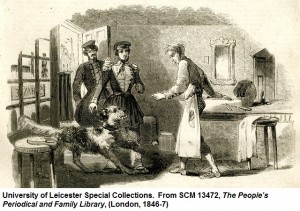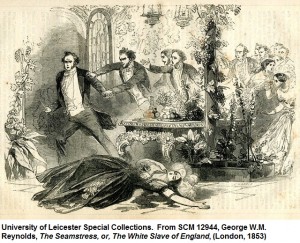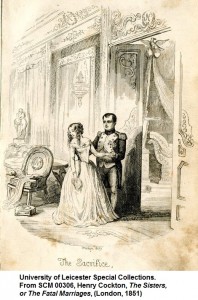Penny Bloods, popular from the 1840s to the 1860s, were so named because of their preoccupation with the gory and sensational. As the name suggests, these serialised novels, published either in periodicals or in weekly autonomous numbers, sold for only one penny – affordable by the growing ranks of the literate working-class. By contrast, novels then cost upwards of 5s, rising to as much as 31s 6d for ‘triple deckers’ (three-volume novels), and Dickens’ serial novels were sold in 1s monthly parts.
The cast of Penny Bloods was portrayed in stark black and white and the plots were melodramatic and bloodthirsty, often centred on the crime and danger of London’s Victorian underworld. Period romances were another favourite theme and the setting almost always had a distinctly Gothic flavour – castles, wild heaths and cliffs, dungeons.
Leicester holds approximately 20 Penny Bloods, a small selection of which is on display in our current exhibition on the 3rd floor of the Library.

‘Oh! To be sure, he came here and I shaved him and polished him off’ … said Sweeney Todd, as he diligently stropped a razor upon his great hoary hand. From SCM 13472, ‘The People’s Periodical and Family Library’, (London, 1846-7).
Sweeney Todd was the most enduring character to make his debut in a Penny Blood. The demon barber, who murders his customers and makes use of their bodies as the key ingredient of mouth-watering ‘veal’ pies, first appeared in The String of Pearls: a Romance, publishedin 18 parts in the People’s Periodical in 1846.
In his day, George W. M. Reynolds’ was a hugely popular author. Two of his Penny Bloods feature in the exhibition. The Mysteries of London sold tens of thousands of copies a week in penny instalments. Reynolds was a Chartist and although The Mysteries is a gothic soap opera with lashings of sex and violence, it has a strong undercurrent of radical politics. Its principal villain, the Resurrection Man, is a body snatcher and serial killer.

The Duchess of Belmont was lying upon the floor of the conservatory, weltering in her blood; and the red dyed fruit-knife, which had inflicted the wound, was held in the hand of Mr. Lavenham … From SCM 12944, George W.M. Reynolds, ‘The Seamstress, or, The White Slave of England’, (London, 1853)
In The Seamstress, or, The White Slave of England Reynolds continued, as the alternative title suggests, to pursue his Chartist agenda, here attacking the ‘middle-women’, who negotiated between the seamstresses and their aristocratic customers – ‘the system is infamous to a degree and the poor workers are its wretched victims’. As always, Reynolds served up his underlying message with plenty of blood and thunder.

‘Sire!’ she exclaimed, ‘I implore you to spare me! Do not; oh! do not destroy me!’ From SCM 00306, Henry Cockton, ‘The Sisters, or The Fatal Marriages’, (London, 1851)
The Emperor Napoleon I made several appearances in Penny Bloods, invariably portrayed in a less than flattering light. In Henry Cockton’s The Sisters, he attempts to blackmail the heroine Lucrece into ‘sacrificing her virtue’ in order to secure the release of her imprisoned husband.
You can find the Special Collections display case on the 3rd floor of the David Wilson Library, towards the front of the building. Entry to the library is free but controlled, so if you are not a student or member of University staff, please ask to be let through the barrier. Details of staffed opening hours are available on the Library website. The exhibition runs until 17 August 2014.


 Subscribe to Margaret Maclean's posts
Subscribe to Margaret Maclean's posts
Recent Comments